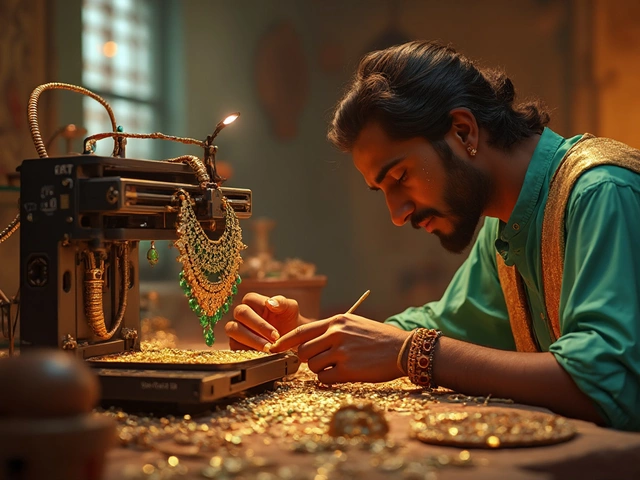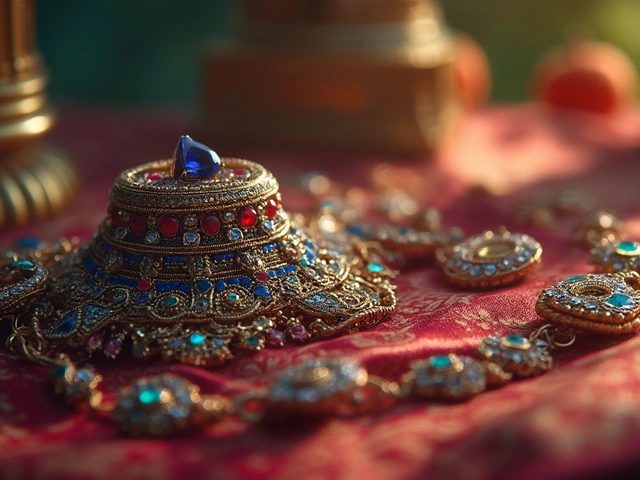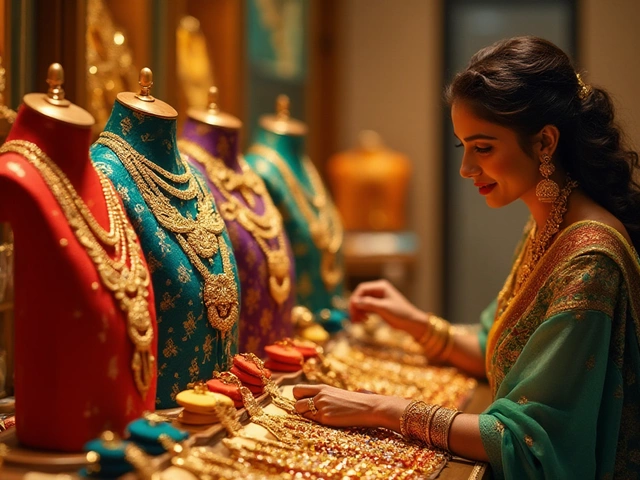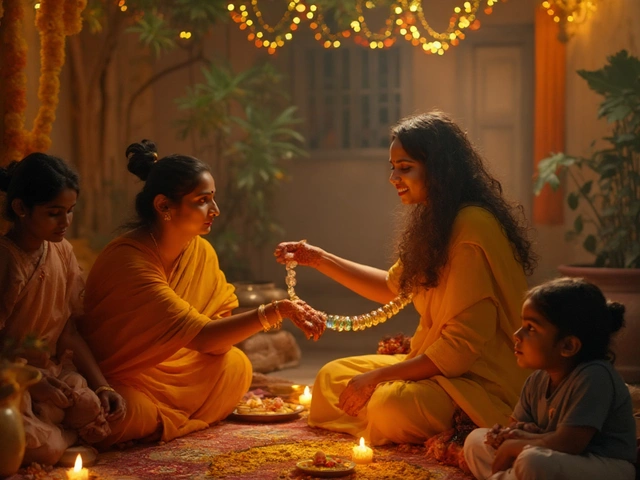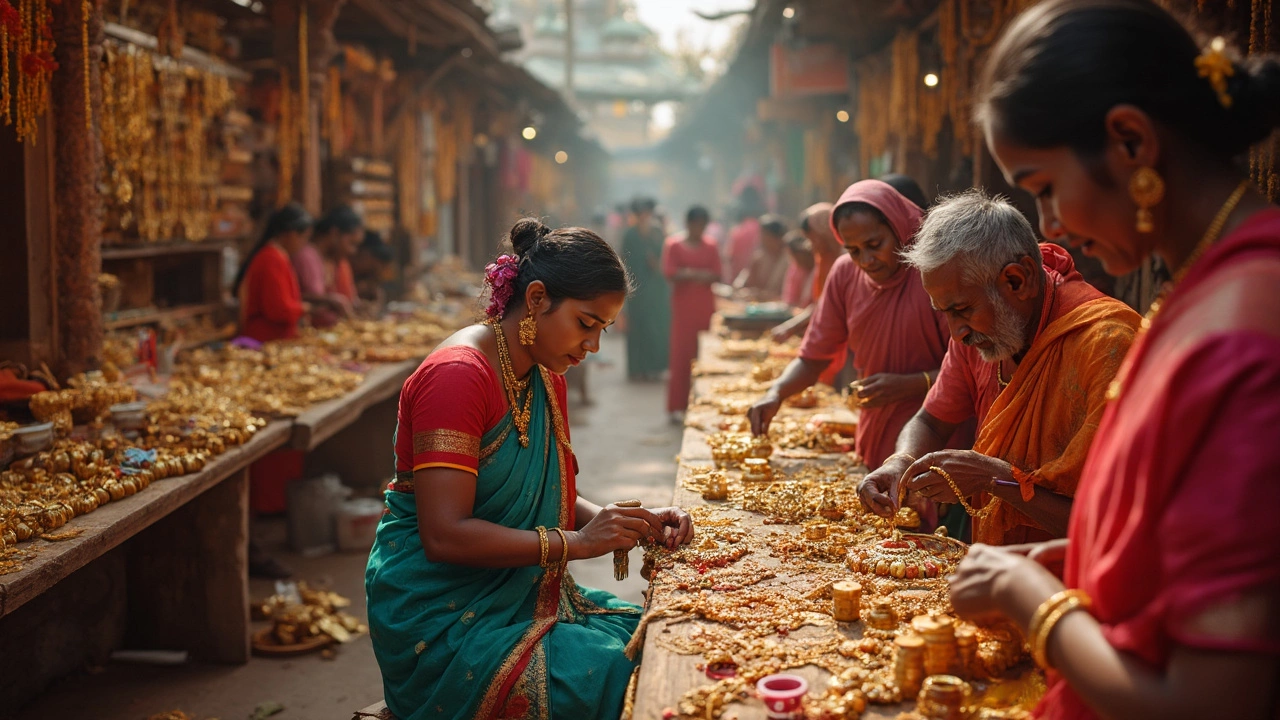
If you ask anyone in India about temple jewellery, you’ll hear one city’s name over and over—Chennai. This city isn’t just popular for its spicy food or beaches; it rules the world of temple jewellery, with a history that stretches back centuries. The artists here turn gold, silver, and gemstones into pieces that feel almost sacred.
Tamil Nadu’s temple jewellery started off as ornaments for Hindu gods and classical dancers—nothing mass-produced here. Chennai’s jewellers learned their skills from old family traditions, passing techniques down generation after generation. It shows in their work—look closely, and you’ll spot tiny carvings of deities, leaves, and flowers in every necklace or bangle.
But why Chennai, out of all the cities in India? Here, whole neighborhoods buzz with workshops dedicated to temple jewellery alone. Shops in places like Mylapore are packed with pieces that range from showy bridal sets to everyday gold earrings influenced by ancient styles. If you want the real deal, it’s hard to beat Chennai—counterfeit pieces just don’t have the same feel or finish.
- The Roots of Temple Jewellery in India
- The City That Sets the Standard
- Signature Styles and Craft Techniques
- Where to Shop: Markets and Trusted Sellers
- Tips for Choosing Authentic Pieces
- Why Temple Jewellery Still Captivates Today
The Roots of Temple Jewellery in India
Temple jewellery isn’t just pretty bling; it actually traces its roots all the way back to the Chola dynasty in South India, as early as the 9th century. These pieces started out as decorations meant especially for Hindu gods and goddesses during temple rituals. Priests and dancers (think Bharatanatyam) wore them as a mark of respect and tradition.
Gold has always been a favorite for temple jewellery, and it’s not just about looking flashy. In Hinduism, gold stands for purity and prosperity—which is why temples and deities were draped in heavy, intricate pieces. Over the years, families in regions like Tamil Nadu became experts, making temple ornaments by hand, using methods that barely changed in hundreds of years.
What makes temple jewellery stand out? You’ll notice designs like Lakshmi, peacocks, lotuses, and other religious symbols. These aren’t random. Every design means something special, usually linked to hope, blessings, or warding off bad luck.
Here’s a simple breakdown of what typically goes into traditional temple jewellery:
- Base metals: Usually pure gold, but sometimes silver.
- Gems: Rubies, emeralds, and uncut diamonds are common.
- Craftsmanship: Hand-carving is key, with each detail done patiently (machine-made versions just don’t match up).
During big temple festivals, it’s not unusual to see idols decked out in huge gold necklaces and chunky earrings, most of them crafted in Chennai. The tradition still thrives, especially when it comes to special family events—weddings, baby showers, and more.
What’s crazy is, according to the Madras Jewellers & Diamond Merchants' Association, temple jewellery is one of the few jewellery arts in India that’s kept its original technique going for over 1,000 years. That’s something you don’t see often in fast-changing fashion trends.
So when you check out a piece of temple jewellery, remember—it’s not just an ornament, it’s a slice of living history that’s still being worn and loved all over India today.
The City That Sets the Standard
When it comes to temple jewellery in India, Chennai has earned a reputation that’s hard to beat. This city isn’t just popular by chance—it’s got centuries of history backing its place at the top. Chennai sits in Tamil Nadu, a region where temple culture and classical arts like Bharatanatyam and Kuchipudi are a huge deal. Jewellery here isn’t just an accessory; it’s tradition, heritage, and deep-rooted pride.
Many of the most famous temple jewellery makers have their roots in the city’s bustling neighborhoods like Mylapore and T. Nagar. Walk through these areas, and you’ll see shops filled with gold belts, chunky earrings, and intricate chokers—all mimicking the grand designs you find in South Indian temples. These designs aren’t new; they’ve been perfected by master craftsmen for more than 500 years.
Chennai has also played a big part in keeping this art alive. Even today, you’ll find entire families where the skills have passed to the fifth or even sixth generation. There are over 1,200 small and medium jewellery workshops dotted around the city’s old quarters. Some of these businesses work mostly with dancers from around India who need authentic pieces for their Arangetram (debut dance performance).
Jewellery from Chennai is known for a few unmistakable features:
- Use of 22K gold as the most common base
- Red and green semi-precious stones like rubies and emeralds
- Traditional motifs—think peacocks, nagas (snakes), and Lakshmi (the goddess of wealth)
- Detailed handwork, never rushed or mass-produced
Just to give you a feel for why Chennai stands out, check this out:
| Aspect | Chennai | Other Cities (Example: Jaipur, Mumbai) |
|---|---|---|
| Main Focus | Temple Jewellery (South Indian style) | Polki, Kundan, Diamond work |
| Gold Purity | Mostly 22K | Varies: 18K-22K |
| Signature Designs | Deities, peacocks, flowers | Floral, geometric, Mughal-inspired |
So, if you want the best temple jewellery india has to offer, Chennai is the place. The trust people have in Chennai’s jewellers runs so deep, my wife Miranda picked out her wedding necklace from a tiny, family-run shop in T. Nagar—and years later, it still grabs attention at every family event.
Signature Styles and Craft Techniques
If you take a stroll through Chennai’s jewelry lanes, you’ll spot some unique stuff right away. Temple jewellery from this city has its own personality—it’s bold, detailed, and full of meaning. The traditional pieces always stand out because they’re inspired by figures from Hindu mythology, like Lakshmi, Ganesha, and peacocks. These aren’t just random designs; every bangle or pendant usually tells a story.
One special thing about Chennai’s temple jewellery is the use of temple jewellery motifs. Craftsmen use a method called repousse—where designs are hammered out from the back to create a 3D effect upfront. This old-school technique gives the pieces that unique, raised look you can spot from across the room.
The base metal is almost always high-quality gold, but silver versions are pretty popular too. Kundan work (a technique where gemstones are set into the metal) pops up a lot, making necklaces and earrings shine without looking over-the-top. You’ll also see uncut rubies, emeralds, and pearls—no modern bling here, but a classy, traditional vibe.
Here are some classic styles you’ll keep running into:
- Oddiyanam: Waist belts with heavy deity designs, often worn for weddings and dances.
- Jhumkas: Bell-shaped earrings with detailed carvings, always in style.
- Vanki: Armlets shaped in a V, usually with peacock or goddess figures.
- Haram: Long layered necklaces that drape almost down to the waist—perfect for brides and dancers.
For the finishing touches, craftsmen use methods like filigree (twisting thin gold or silver wires for texture), and granulation (adding tiny metal beads for that dotty background). These techniques are all about patience; a single statement piece can take days—sometimes weeks—to finish, depending on the detail and gemstones involved.
If you’re checking for quality, pay attention to the back of the jewellery. Handcrafted pieces usually have smooth edges, neat soldering, and secure stone mounts. Machine-made ones just don’t have that careful touch Chennai’s artisans put in.
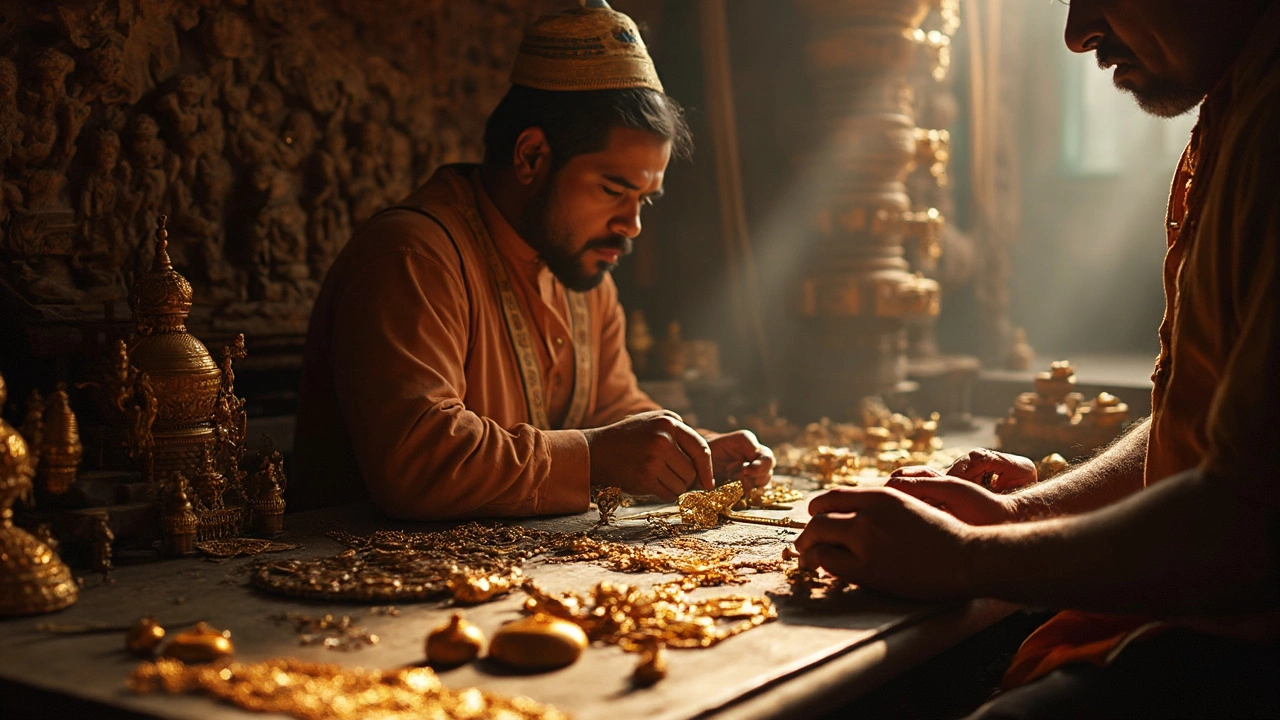
Where to Shop: Markets and Trusted Sellers
If you want the best temple jewellery in India, you absolutely need to know where to shop in Chennai. Some places stand out for a reason—they’ve been trusted for generations and are known across the country for quality and honesty.
Start your hunt in Mylapore. This neighborhood is almost legendary. Walk down North Mada Street, and you’ll see rows of jewellers packed with intricate gold earrings, heavy necklaces, and old-school bangles. Stores like GRT Jewellers and NAC Jewellers aren’t just famous in Chennai—they’re names people recognize in jewellery circles everywhere. They keep their designs super close to tradition and have trained staff who’ll happily explain differences between old and new styles.
Pondy Bazaar in T. Nagar is another hotspot. It’s busy, noisy, a little overwhelming, but it’s where serious buyers and families go, especially during festival or wedding seasons. Retailers like Prince Jewellery have large collections, and staff are happy to show you everything from chunky antique pieces to lighter daily-wear temple jewellery.
If you’re after real heritage, seek out smaller shops in the George Town district. This is old Chennai, and some streets here have shops that have been selling jewellery for over a century. The quality checks are strict, and jewellers here pride themselves on keeping things traditional and straightforward.
- Always ask for hallmarked gold or certified silver for peace of mind.
- If you’re interested in custom work, chat directly with the craftspeople at the store—many will let you see their tools or sketches.
- If you want to compare prices, never hesitate—bargaining isn’t rude, it’s expected.
For convenience, most of the top jewellers now have detailed websites. Some even let you preview collections online, or set up appointments for personalized shopping if you want the VIP treatment. If in doubt, jump online and check the seller’s reviews, or ask local dancers—they’re the real pros when it comes to recognizing temple jewellery worth your money.
Tips for Choosing Authentic Pieces
Finding real temple jewellery in Chennai can be tricky, especially with so many lookalikes flooding the market. But if you pay attention to a few details, you’ll walk away with something truly special.
- Temple jewellery should feel weighty. Genuine gold and silver always have a certain heft to them. If a necklace or anklet feels too light for its size, it’s probably not the real deal.
- Check for hand-carved details—this type of jewellery is all about tiny gods, goddesses, and mythological symbols. You’ll see clear, sharp lines and symmetrical patterns, unlike mass-produced pieces that have blurry or uneven designs.
- Most authentic pieces use red and green stones. These aren’t always real rubies or emeralds, but the setup stays faithful to tradition. If you spot a piece with bright blue or pink stones, it’s likely modern or imitation.
- Look for hallmark stamps if it’s gold. In India, a BIS hallmark is a solid sign of purity. For silver, check for 92.5 or "Sterling" marks. Don’t be shy—ask the seller to show you the mark.
- If you’re unsure, ask the seller about the history of the piece or the workshop. The best shops in Chennai, especially in areas like Mylapore, will be happy to explain who made it and even how it was crafted.
If you want extra peace of mind, compare the price per gram with market rates. Genuine gold jewellry prices will stay close to the day’s gold rate, plus a premium for craft work. If a piece seems suspiciously cheap, something’s off.
| What To Check | What To Expect |
|---|---|
| Weight | Slightly heavy, never flimsy |
| Stone Color | Mainly red & green |
| Design | Sharp, detailed patterns |
| Hallmark | BIS (Gold), 92.5 (Silver) |
| Price | Close to current gold/silver rates |
One last tip: avoid buying temple jewellery from roadside sellers or unverified online stores. Trusted stores in Chennai usually offer bills and purity certification. This way, you know exactly what you’re getting—with zero surprises down the road.
Why Temple Jewellery Still Captivates Today
Temple jewellery isn’t just about tradition—it’s still a style statement and a cultural icon in 2025. Even with new jewellery trends popping up every season, people keep coming back to these timeless designs. Isn’t it wild how a style that started in ancient temples now shows up at weddings, dance shows, and even on Instagram influencers?
One big reason: the craftsmanship. You can spot a real piece of temple jewellery because every detail is carefully hand-done. For example, the Kundan work you see in South Indian earrings is still made using the same techniques from historical times. Gold is usually the base, but silver is catching up thanks to younger shoppers wanting a modern twist on classic styles.
The value goes beyond looks. In South India, brides often choose temple jewellery for its good-luck symbolism—certain motifs, like Lakshmi (the goddess of wealth), are supposed to bring blessings to a marriage. And if you’re someone who loves classical dance, odds are you’ve worn temple pieces on stage. Bharatnatyam dancers can’t do a proper performance without it.
- Temple jewellery sales see a spike during wedding seasons (especially May-July and November-January).
- Collectors often look for hallmark stamps and small certificates as proof of authenticity.
- The most popular items? Jhumkas (dangling earrings), vanki (armbands), and traditional chokers that double up as hair ornaments.
Some jewellers in Chennai say about 60% of their wedding orders are still based on classic temple designs. People like knowing what they buy has history and meaning—not just fashion. That’s what keeps temple jewellery on top, generation after generation.

